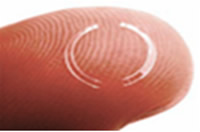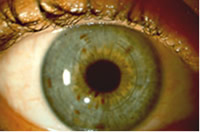Intacs (phakic IOL's)
Definition
Intacs are a form of refractive surgery in which small plastic ring segments are placed within the cornea to correct myopic (nearsightedness) refractive error and decrease or eliminate the need for glasses or contact lenses. Intacs are also sometimes used to help decreased corneal warping in patients with keratoconus.
How do Intac implants Work?
In myopia, the cornea is curved too steeply and has too much refractive power for the eye. As a result, the light coming into the eye comes to a focus in the middle of the eye rather than on the retina, and a blurry image results. Intacs, which are inserted into the middle of the cornea, work by flattening the central cornea and reducing its refractive power. As a result, the incoming light becomes focused more sharply on the retina.
For people with keratoconus, the cornea starts to thin and protrude forward at a point just below its center resulting in irregularly curved corneas and high levels of astigmatism that are difficult to correct with ordinary glasses and contact lenses. Intacs can sometimes help normalize the central corneal shape and improve vision. When Intacs are placed in the cornea, they help make the central curvature of the cornea more regular and can improve vision greatly in these patients.
The main advantage of Intacs over laser refractive surgery procedures is they are removable and exchangeable. Thus, the procedure can be reversed or easily revised if need be. However, only lower levels of myopia can be treated with Intacs and the devices cannot correct for astigmatism and hyperopia. As such, fewer patients are candidates for Intacs refractive surgery.

| 
| |
| Intacs intracorneal ring | Intacs segments placed | |
| segments | inside the cornea |
Who are candidates for Intacs?
In general, candidates for Intacs should be:
- 21 years of age or older: younger people may still have eyes that are growing. In certain cases, individuals younger than 21 may have LASIK surgery.
- There is no upper age limit for Intacs.
- Dissatisfied with wearing glasses or contact lenses.
- Have had no change in glasses or contact lens prescription for at least a year.
- Have otherwise healthy eyes.
- Be willing to accept a small amount of risk associated with surgery.
- Understand that glasses and/or contacts are occasionally still needed for some activities after surgery.
- Not have excessively thin corneas or extremely high levels of refractive error. Your doctor will test for these conditions on your evaluation exam.
These conditions may prevent you from having Intacs implanted. You should alert your eye surgeon if you have one or more of these conditions so that he or she can help you make the best choice about undergoing refractive surgery:
Condition:
Reason for caution:
Examination prior to Intacs
Before you arrive at the doctor's office
If you wear contact lenses you must stop wearing them prior to surgery–at least two weeks for soft contacts and one month for hard contacts. This is because contact lenses can cause mild warping of the corneal shape, which may interfere with the preoperative measurements of the eye and calculations for refractive surgery.
Tests you may have at the doctor's office
The evaluation for Intacs surgery typically includes a complete eye exam of the front and back of the eye, plus several additional tests including:
- Your vision with and without glasses will be tested, as well as a refraction to determine if your current vision differs markedly from the vision corrected in your current glasses. If they do differ markedly, you may need to return for another visit several weeks later for a repeat refraction to insure that your prescription is not changing.
- The thickness of your corneas will also be tested. Since the Intacs segments must be placed within the cornea, the cornea must thicker than a certain minimum thickness.
- Your pupil size will also be examined. People with large pupils may be at increased risk for night vision symptoms, such as glare and halos, after Intacs refractive surgery.
- Lastly, several machines may be used to assess the shape of your cornea, including a topographer and/or a tomographer. Your doctor will review the information from these machines in order to determine if your corneas are appropriate for Intacs surgery.
Is 20/20 vision guaranteed with Intacs refractive surgery?
The majority of people that undergo Intacs refractive surgery are very happy with their post-procedure vision. In fact, a person's happiness with their vision after the procedure is a far more important measure of success than the somewhat arbitrary "20/20" measurement done in a dark room of a doctor's office.
In the clinical trials of Intacs for the correction of low myopia, 97% of patients saw better than 20/40, the minimum visual acuity to drive without glasses in most states. Additionally, 74% saw 20/20 or better. Though a high percentage of patients achieve 20/20 vision with Intacs, an even higher percentage typically achieve 20/20 vision or better with excimer laser surgeries, such as LASIK or PRK. For this reason, Intacs surgery is used less for correction of low-level myopic refractive error than LASIK or PRK.
Additionally, although Intacs is a very precise refractive surgery technology, the individual healing effects of each patient causes variability of response to the treatment. With Intacs, like any refractive surgery, 20/20 vision cannot be guaranteed, although the odds that the vision will be that good or better are very high.
What are the risks of Intacs Refractive Surgery?
The risks of these surgeries fall into two main categories: Vision Loss Risks, and Nuisance Risks.
Vision Loss Risks
It is very rare to lose vision after Intacs refractive surgery. When vision is lost in an otherwise uncomplicated procedure, it typically is 2 or less lines on the eye chart of best corrected vision even with extra help from glasses. As such, this surgery has a very good safety profile. One serious complication, infection, does exist, however, which could cause significant visual loss.
- Infection: Since cuts are made on the eye, it is possible that bacteria could gain access to the corneal tissue and start an infection. Scarring from such an infection could lead to vision loss. This is very uncommon as powerful antibiotics are used after surgery to prevent infection. The risk of severe infection is less than 1 in 500.
Nuisance Risks
Most of the other risks associated with Intacs surgery don't usually cause a significant loss of vision. Rather, they can cause nuisance problems with the eyes that may not have been present before the surgery.
- Epithelial Healing: In most cases, the scratches made on the surface of the cornea for Intacs heal within 3-5 days. A bandage contact lens may be left in the eye during this time to promote healing. Eye drops are also given to help healing. Occasionally, though, it can take up to several weeks for the surface cells to heal, during which time the vision can be blurry.
- Induced Astigmatism: Sometimes the placement of Intacs segments can cause astigmatism to develop that was not previously there. This may require glasses, contact lenses or additional refractive surgery in order to treat it. Typically astigmatism created by Intacs segments is very low and not noticeable to the patient.
- Night Vision Symptoms: Some patients notice their night vision after Intacs refractive surgery is different than before. Usually, this occurs in the form of halos around streetlights, added glare from oncoming traffic or increased difficulty seeing dimly light shapes in the dark. People with larger nighttime pupils may be at higher risk for this nuisance complication. Most people with night vision complaints find them only mildly annoying; however, a few individuals may feel that they are unable to function well in low light settings. Medications can be used to change the size of the pupil in low light or nighttime settings, which can help reduce night vision symptoms if they occur.
- Enhancements: Even though Intacs surgery is very precise, the fact that the eye is a living tissue and that individual healing response can vary means that refractive surgery may over or under correct the refractive error of the eye. If this happens, a "touch up" procedure may be necessary if the vision is not fully corrected by the initial procedure. This could involve exchanging the Intacs segments for different sized segments, adding PRK excimer laser treatment to the cornea, or using small incisions in the cornea to correct residual astigmatism. Enhancement procedures carry a small risk of all of the above complications, just like the original procedure.
What will I experience during the Intacs procedure?
On the morning of your procedure, your surgeon will ask you not to wear any makeup because it could stain the cornea and increase the risk of infection. At the laser surgery center, you will usually be given a Valium pill to help you feel calm during the procedure. The procedure itself usually takes less than 10 minutes per eye.
You will lie on a special bed under the laser. A lid holder will be placed to help hold your eyelids open after numbing drops are placed on the eye. A small incision is made in the eye, and then a tunnel is created through the cornea with a special instrument. During the tunnel creation you will feel some squeezing and pressure on the eye since the instrument is held in place by a suction device. The plastic Intacs segments are placed inside the cornea and a small suture is used to seal the wound. A bandage contact lens and eye drops are applied.
After the procedure is done, your surgeon may examine your eye, or simply have you go home and take a long nap. The eyes will start to burn and feel irritated about half an hour after the surgery as the numbing medicine wears off. The nap, plus the eye drops your surgeon will give you will help make your eyes feel more comfortable. Your doctor will see you the next day, at which point the eyes are usually feeling pretty comfortable. You will typically see your doctor again in about a week to assess the healing of the surface cells and remove the contact lens. You will continue using eye drops for several weeks after the surgery, and then see your doctor again in about a month for a vision check. If all is well, as it typically is, your doctor will usually see you again in 6 months to a year for another vision check. During the few months after the surgery, artificial tears should be used regularly to help limit dryness of the eyes while they heal.

